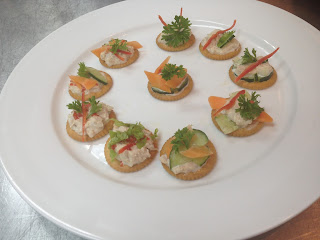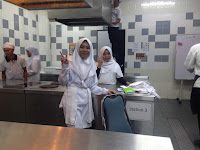PURCHASING, RECEIVING AND STORING FOOD - CHAPTER 4
The meaning of Purchasing
- Purchasing is the process of getting the right product into a facility at the right time and place, plus the amount of goods at the right price and right source. An act of buying. It is a complex activity because it involves a lot of decision making in obtaining the best quality with the least money, time and energy.
The meaning of Receiving
Receiving is the point at which food service operation inspects and takes legal ownership and physical possession of items ordered. Its purpose is to ensure that the food and supplies delivered match the establish quantity and quality specifications.
The meaning of Storing
The purpose of storing is to ensure a constant supply of needed goods. Is an important factor in the prevention and control of loss or waste. Perishables need to be immediately refrigerated. (Cold storage). Staples and dry goods should be stored in an orderly and systematic arrangement. (Dry storage)
Food Suppliers
Approved Sources
- Food must be obtained from reliable sources.
- Choose supplier who are sell clean, fresh, uncontaminated food products.
- Sources are routinely inspected to make they follow good manufacturing practices.
Inspecting Merchandise
Avoid Temperature Abuse
Food Suppliers
Approved Sources
- Food must be obtained from reliable sources.
- Choose supplier who are sell clean, fresh, uncontaminated food products.
- Sources are routinely inspected to make they follow good manufacturing practices.
Inspecting Merchandise
- Check condition of delivery truck
- Check temperature during receiving.
- Reject packages
- Examine the food contents and quality
- Check contamination of raw and prepared food.
- Foods should not contain unproved additives
- Reject shipment
Determining Food Quality
- The senses of smell, touch, sight and taste frequently used to evaluate the quality of foods.
- The product containers should also be checked for tears, punctures, dents or other signs of damage.
- Spoiled foods frequently give off foul odors indicative of compounds such as ammonia and hydrogen sulfide (the smell of rotten eggs)
- Milk develop acidic taste and bitter.
Avoid Temperature Abuse
- Thermometers are used to check the temperature of foods during receiving, final cooking, in storage and during display including cleaning and sanitizing.
- Temperature abuse is used to describe situations when foods are;
- - Exposed to temperature in the temperature danger zone for enough time to allow growth of harmful microorganisms.
- - Not cooked or reheated sufficiently to destroy harmful microorganisms.
Receiving Fresh Food
- MEAT
- Beef Color: bright, cherry red
- Lamb Color: light red
- Pork Color: pink lean meat, white fat
- Texture: firm and springs back when touched
- POULTRY
- Color: no discoloration
- Texture: firm and springs back when touched
- Odor: none
- Packaging: should be surrounded by crushed self-draining ice
- FISH
- Color: bright red gills, bright shiny skin
- Odor: mild ocean or seaweed smell
- Eyes: bright, clear and full
- Texture: firm flesh that springs back when touched
- SEAFOOD
- Odor: mild ocean or seaweed smell
- Shells: closed and unbroken (shellfish): hard and heavy shells (lobsters and crabs)
- Condition: if fresh, they are received
- MILK AND DAIRY PRODUCTS
- Milk: sweetish flavor
- Butter: sweet flavor, uniform. color, firm texture
- Cheese: typical flavor and texture and uniform color
- EGGS
- Odor: none
- Shells: clean and unbroken
- Condition: firm, high yolks that are not easy to break and whites that using cling to yolks
- FRUITS AND VEGETABLES
- Slightly blemished can accepted if flavor and quality are not affected
- All must thoroughly washed before serve
Processed Food
- Frozen Food
- Internal temperature of 0 F
- Don't accept thawed and refrozen
- Refrigerated Food
2. CONTAINERS
- Temperature of 41 F or below
- Packaging damaged is signs of contamination
- Packaged Food
- Packaged foods must be process and well package
Receiving Processed Foods
- Canned Foods
- Employee must checked damage
- Spot-check the canned goods and discard items that are foamy or milky
- Reject cans if you find the following: swollen ends, rust, dents, missing labels and dry foods
- Dry Foods
- Foods received at room temperature and its packaging should be intact and in good condition
- Reject the product if the packaging is damp, has moisture stains or is torn, or punctured
- The product should also be rejected if: contains insects, insect eggs, or rodent droppings, has an abnormal color or odor, contains spots of mold, has a slimy appearance
- Packaged Foods - Modified Atmosphere Packaging
- Terms used to describe food processing methods where food is packed using a system that withdraws all air from the package
- Gases (nitrogen and carbon dioxide) be added after the air is removed to aid in preserving food
- This can maintain flavor and extend shelf life as long as it is handled properly
Protecting stored food
- FIFO
- Food product should be used in order which they are received
- keep track on food received
- the new deliver put behind older stock to make sure the older food used first
- the special care in repacking for storage
- prevent contamination by keep food covered
- clearly label repackaged foods.
3. PLACEMENT
- prevent food from dripping on the other food products
- raw food should be separated from ready-to-eat food (put below)
- store food at a minimum of 6 inches above the floor
4. CONTAMINATION
- store food only in designated areas
- protect from dust, flies, rodents, pest etc
- protect from cross - contamination



Comments
Post a Comment